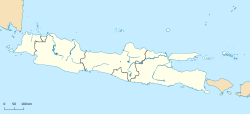This article relies largely or entirely on a single source .(October 2025) |
 Pajajaran Stadium | |
Location in Java | |
| Address | Jl. Pemuda No.2, Tanah Sareal, Tanah Sereal, Bogor, West Java 16162 Indonesia |
|---|---|
| Location | Bogor, West Java |
| Coordinates | 6°34′38″S106°47′52″E / 6.577165°S 106.797661°E |
| Owner | City government of Bogor |
| Operator | City government of Bogor |
| Capacity | 12,000 |
| Surface | Grass field |
| Tenants | |
| PSB Bogor | |
Pajajaran Stadium is a multi-use stadium in Bogor, Indonesia. It is currently used mostly for football matches and is used as the home venue for PSB Bogor. The stadium holds 12,000 people. [1]
